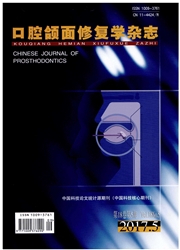

 中文摘要:
中文摘要:
目的:探讨用蛋白质组学iTRAQ技术分析下齿槽神经缺失大鼠下颌骨牵张成骨牵张期新生组织蛋白表达的改变.方法:6只大鼠随机分为2组,实验组为下齿槽神经缺失大鼠下颌骨牵张成骨,对照组为正常大鼠下颌骨牵张成骨,均进行单侧下颌骨牵张,速率:0.2mm/12h,牵张期为10d,下颌骨牵张成骨牵张期第10d取材.将取材的新生骨组织标本进行理化性分析、蛋白质提取及蛋白质定量检测.应用iTRAQ技术对蛋白质样本进行检测,寻找及鉴定差异蛋白.结果:应用iTRAQ技术质谱鉴定出置信度95%的蛋白315种,共鉴定出差异蛋白146个,其中上调≥1.5倍的39个,下降≤0.8倍的58个.结论:感觉神经系统在牵张成骨的成骨过程中起到一定调控作用.筛选出多种下齿槽神经缺失下颌骨牵张成骨牵张期新骨形成相关的差异蛋白,为进一步验证感觉神经缺失对下颌骨牵张成骨新骨形成相关蛋白质奠定了基础.
 英文摘要:
英文摘要:
Objective: To investigate changes of protein expression of new tissue during mandibular distraction osteoge- nesis of rate with inferior alveolar nerve resection by using the iTRAQ technology. Methods: Six rats were randomly divid- ed into two groups, the experimental group was treated with inferior alveolar nerve resection and unilateral mandibular dis- traction, and the control group was only treated with unilateral mandibular distraction. The mandibular distraction was car- fled out at the rate of 0.2mm/12h for 10 days. Specimens of new bone tissues were collected on Day 10 for physical and chemical analysis, quantitative detection of protein extraction. The iTRAQ technology was used for sampling and identify- ing differentially expressed proteins. Results: 315 species of proteins were identified at iTRAQ technology mass spectrome- try confidence level of 95%. 146 species of differentially expressed proteins were identified, among which 39 raised more than 1.5 times and 58 down 0.8 times. Conclusion: Sensory nervous system plays a role in regulating distraction osteogene- sis process. The identification of the differentially expressed proteins relating to mandibular distraction osteogenesis of rat with missing inferior alveolar nerve facilitates a further verification of proteins associated with new bone formation during mandibular distraction osteogenesis under missing sensory nerve.
 同期刊论文项目
同期刊论文项目
 同项目期刊论文
同项目期刊论文
 A Comparison of Stromal Cell-Derived Factor-1 Expression During Distraction Osteogenesis and Bone Fr
A Comparison of Stromal Cell-Derived Factor-1 Expression During Distraction Osteogenesis and Bone Fr 期刊信息
期刊信息
